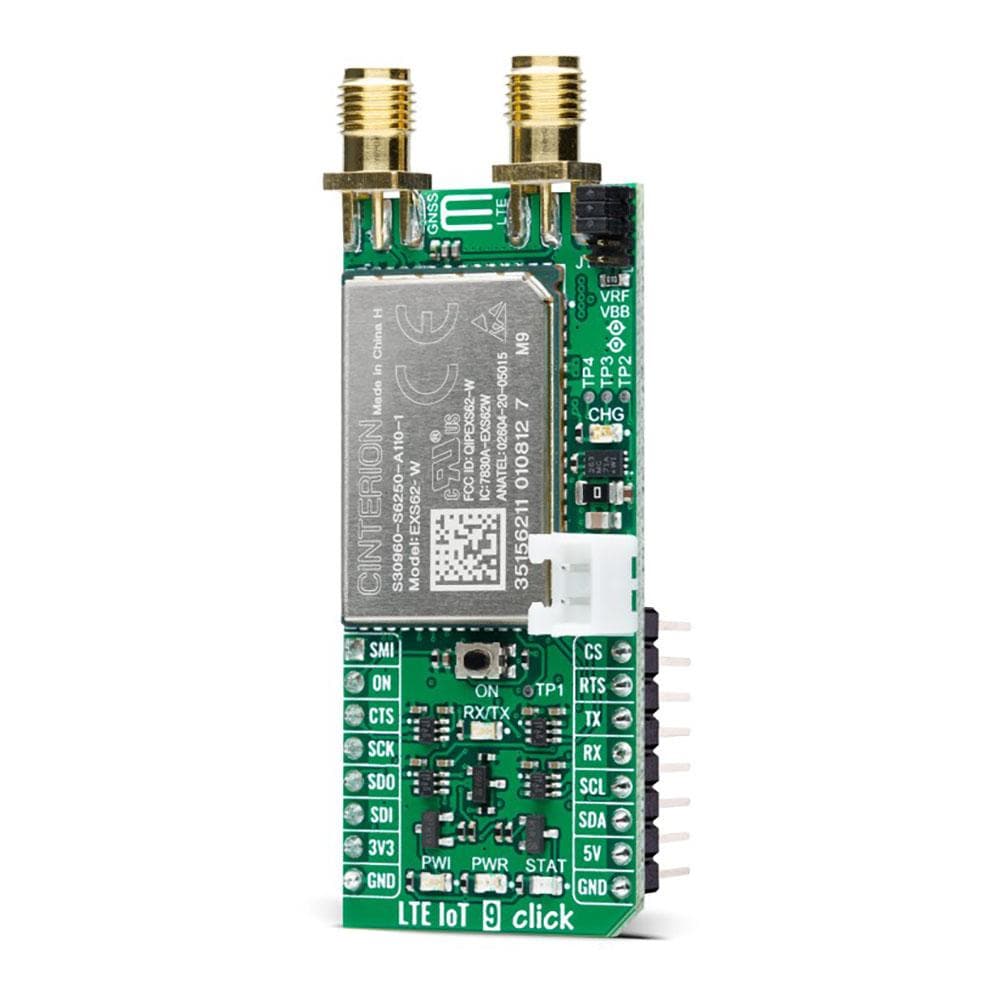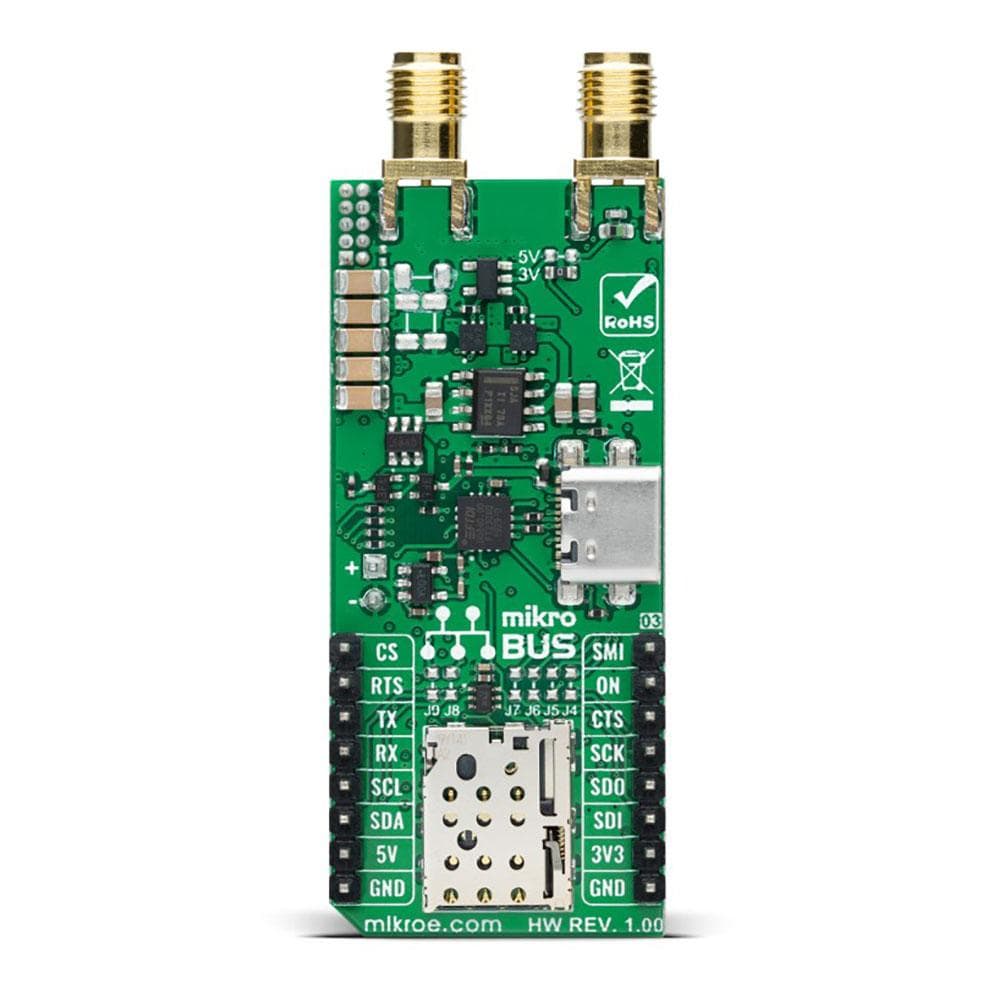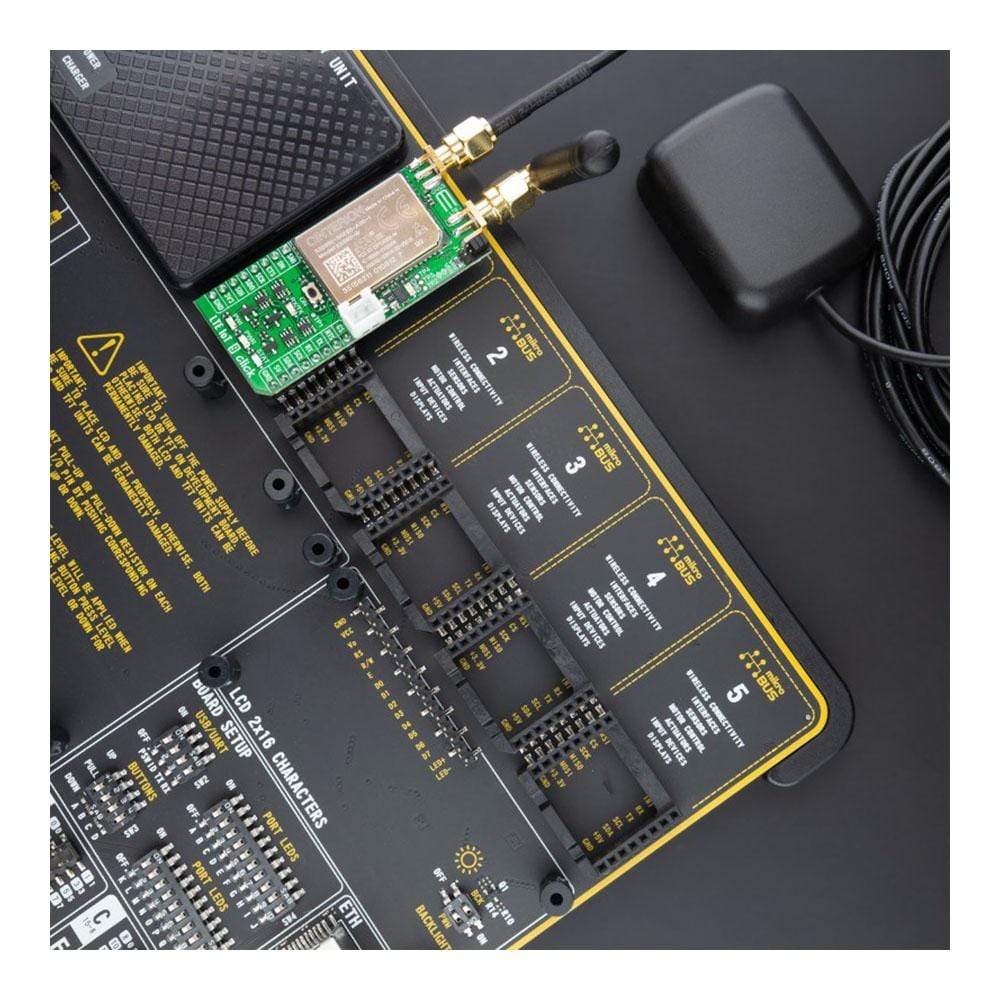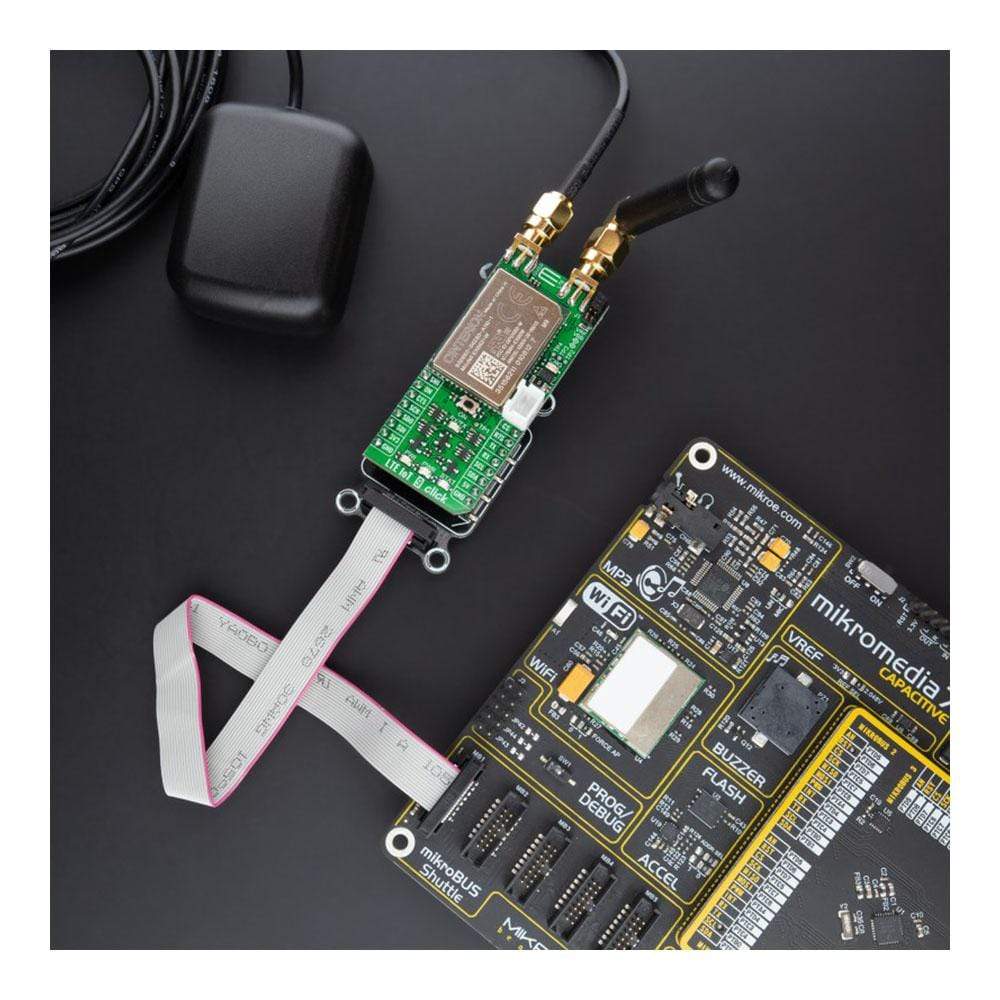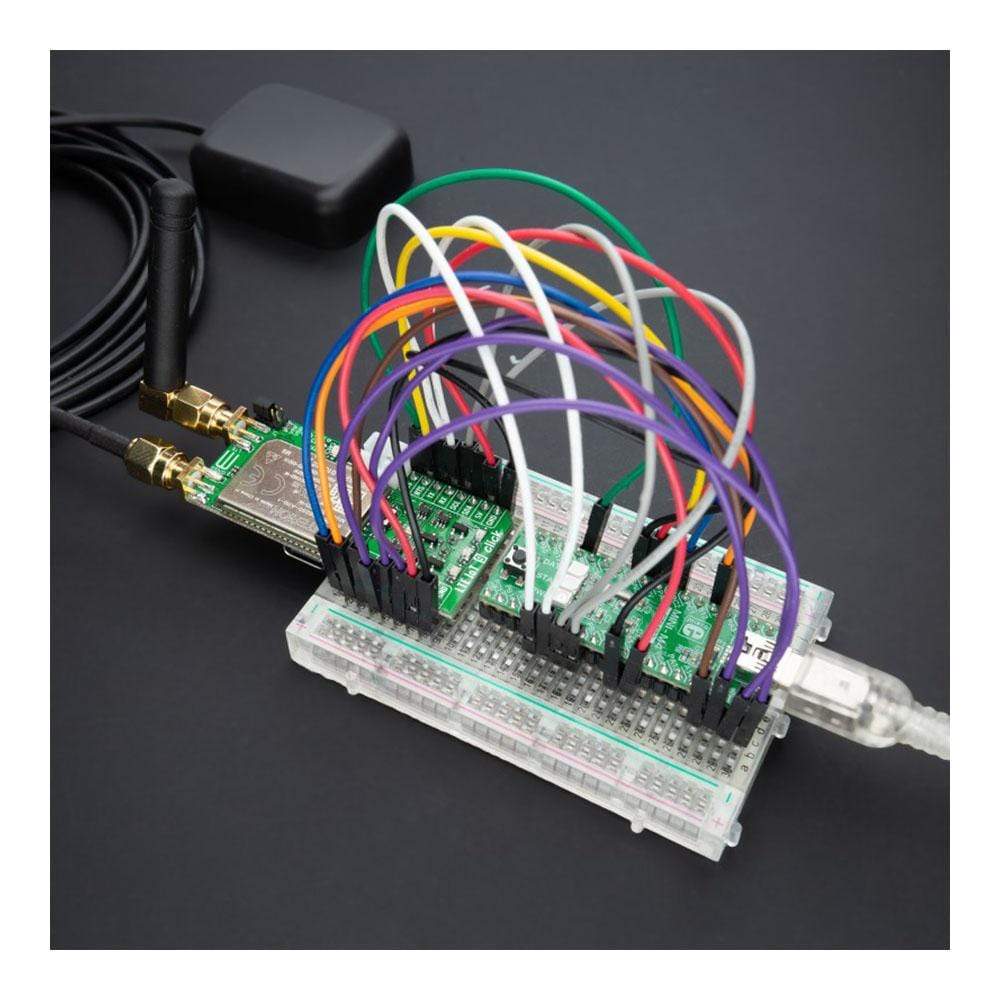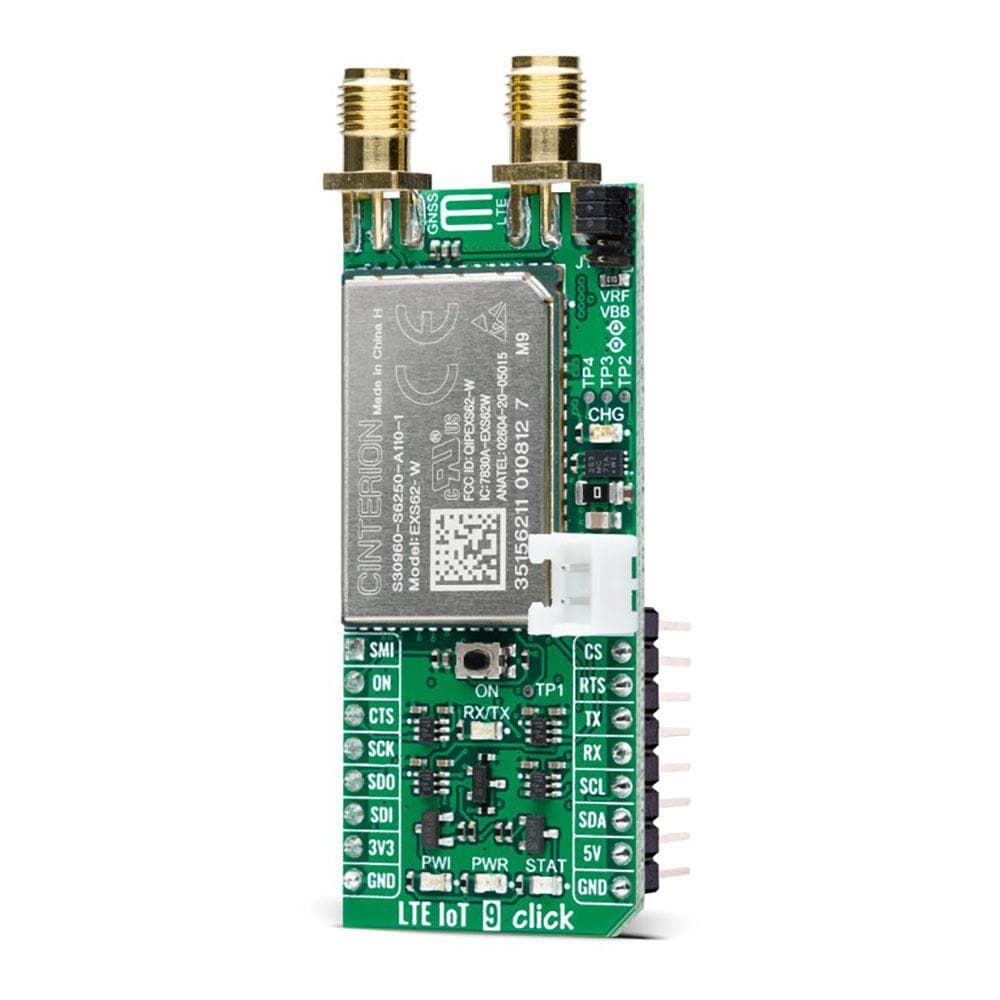
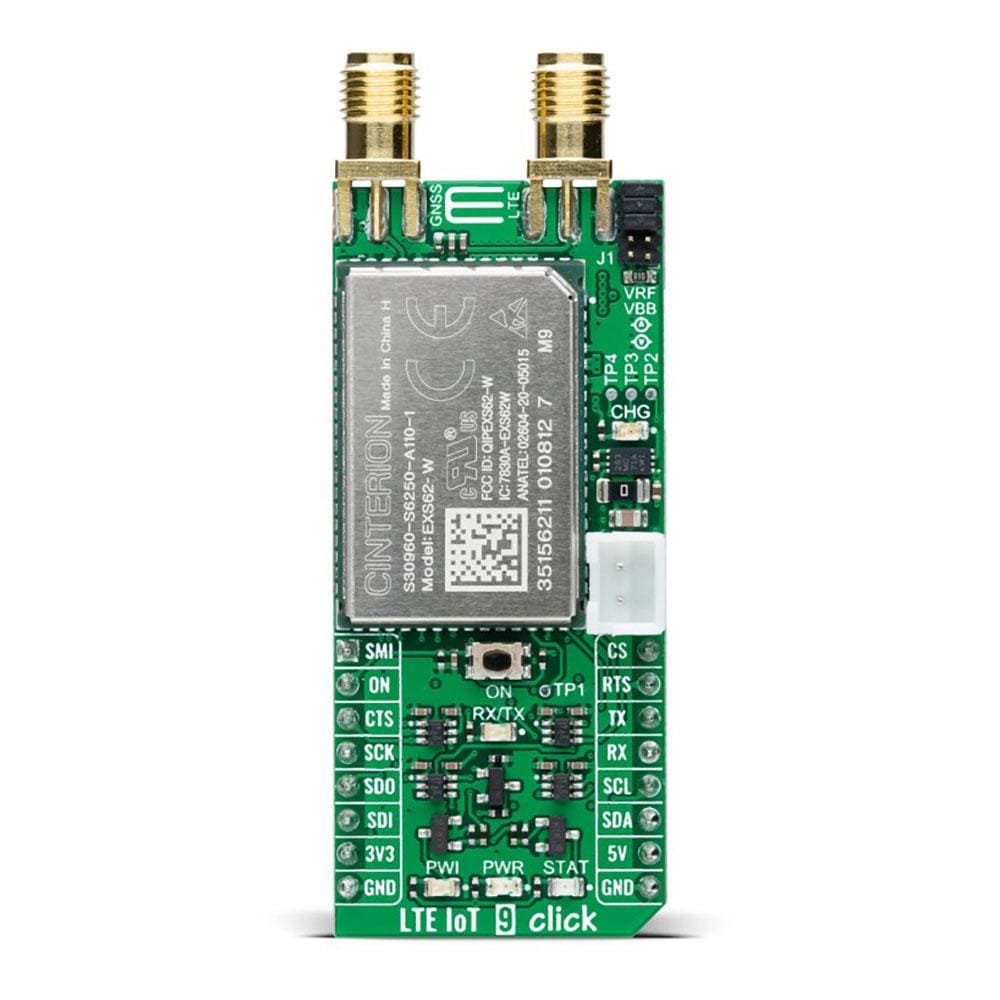
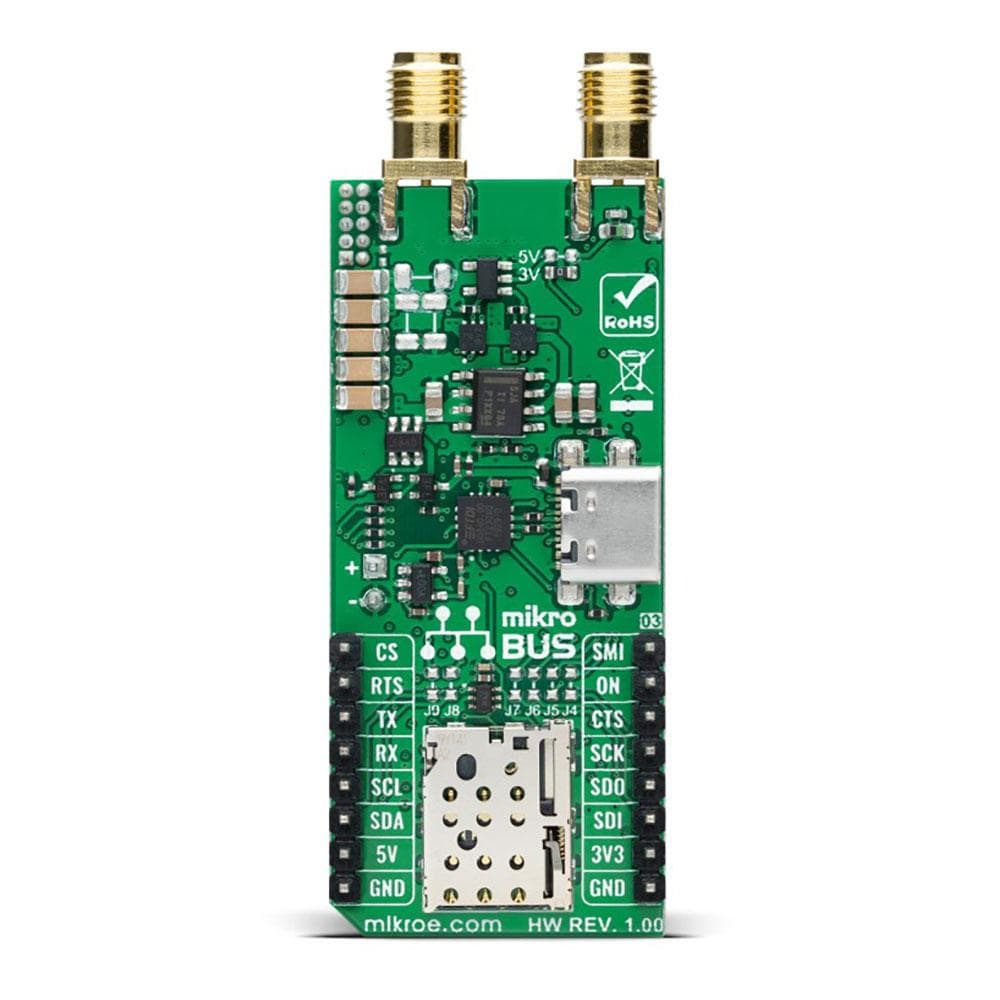
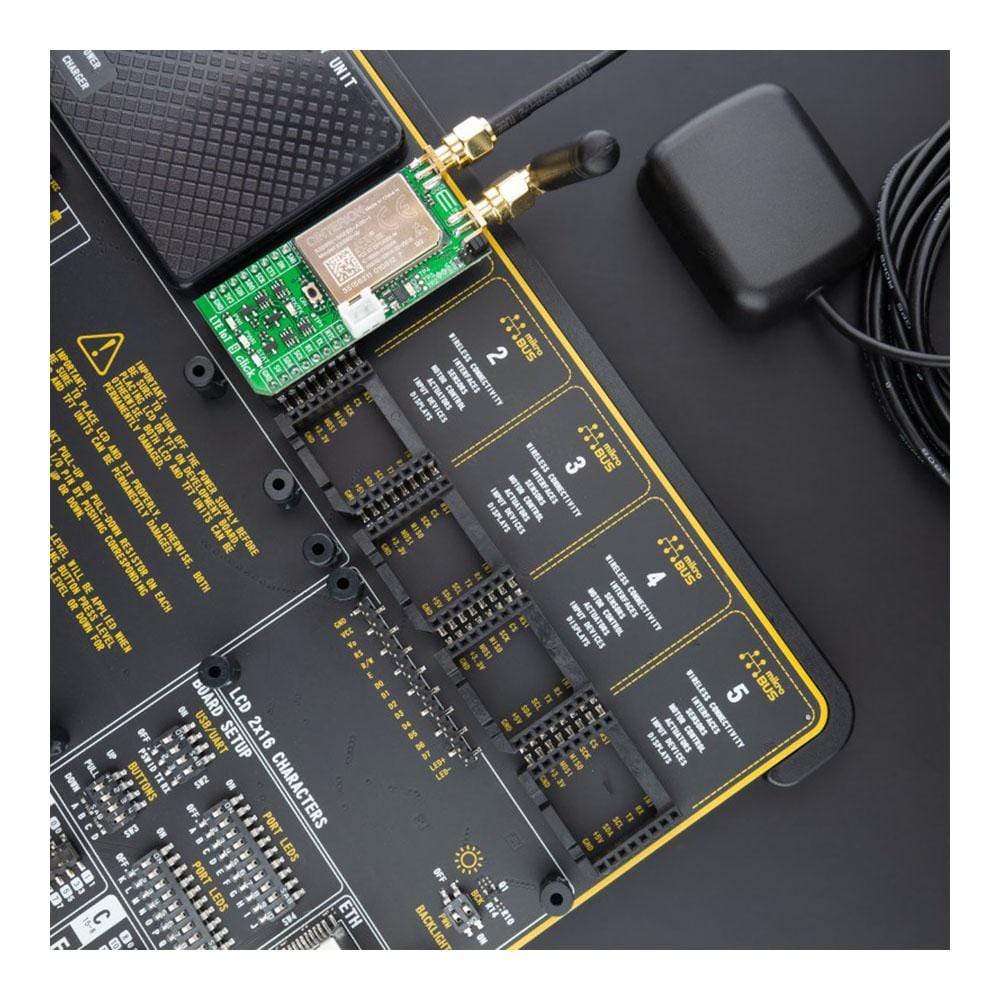

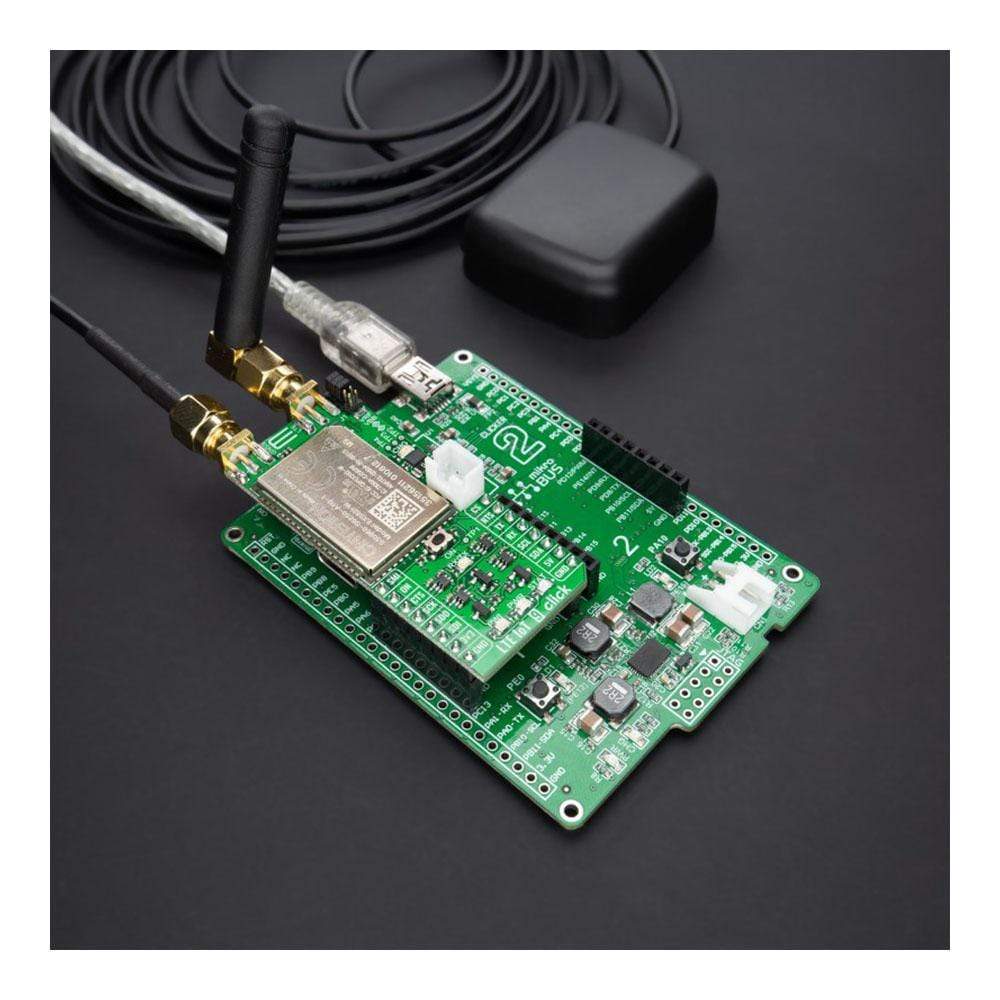
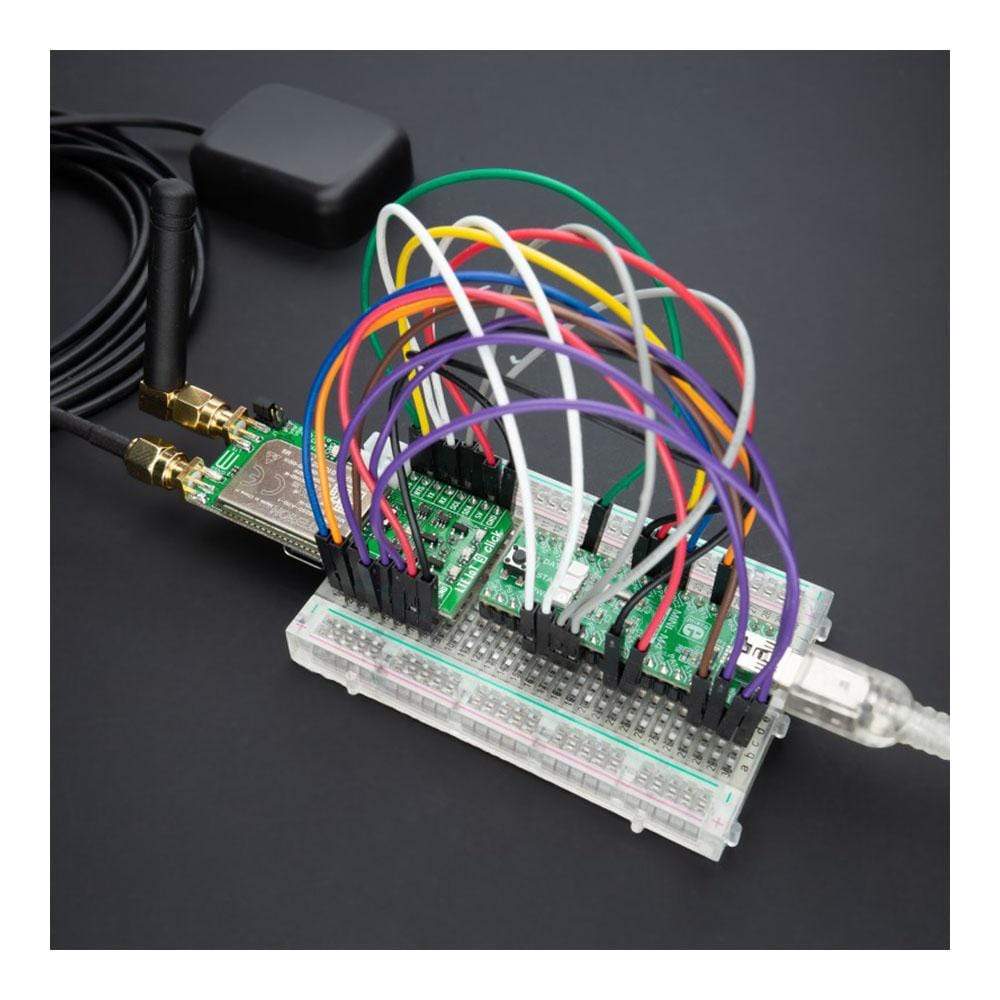
Overview
The LTE IoT 9 Click Board™ is a compact add-on module that contains a Low Power Wide Area (LPWA) Wireless IoT module which is 3GPP Release 14 compliant. It allows connections to the LTE CAT-M1 and CAT NB1/2 networks. This board features the EXS62-W, LTE-IoT Wireless Module from Thales that offers a rich set of Internet protocols and industry-standard interfaces such as UART, USB, etc. Global IoT connectivity, integrated GNSS support, SMS support, extended coverage range, and reduced power consumption make this single IoT module an excellent choice for device makers while ensuring worldwide reliability. This Click Board™ is suitable for logistics and asset tracking, predictive maintenance, industrial, smart agriculture, and many more applications.
The LTE IoT 9 Click Board™ is supported by a mikroSDK compliant library, which includes functions that simplify software development. This Click Board™ comes as a thoroughly tested product, ready to be used on a system equipped with the mikroBUS™ socket.
Downloads
How Does The LTE IoT 9 Click Board™ Work?
The LTE IoT 9 Click Board™ as its foundation uses the EXS62-W, a cellular IoT Module from Thales that supports 3GPP Release 14, global machine type communication (MTC) technologies, NB-IoT, LTE M, and 5G-enabled LPWA connectivity for industrial applications. It provides integrated GNSS support and delivers up to 20dBm of power, providing a downlink data speed of up to 300Kbps and an uplink data speed of up to 1.1Mbps. State-of-the-art security features protect the device and data and provide secure enrollment in cloud platforms enabling trust in the IoT ecosystem. The module's simplified power supply design and advanced management system extend battery lifetime.

The LTE IoT 9 Click Board™ is equipped with a USB type C connector. It allows the module to be powered and configured by a personal computer (PC) using FT230X, a compact USB to a serial UART interface device designed to operate efficiently with USB host controllers. It uses as little bandwidth as possible when compared to the total USB bandwidth available.
Also, it possesses two SMA antenna connectors with an impedance of 50Ω, labelled as GNSS and LTE, used for connecting the appropriate antenna that MikroE has in its offer. The integrated GNSS receiver supports the NMEA protocol, representing combined electrical and data specifications for communication between various electronic devices, including GNSS receivers. By default, the GNSS receiver is OFF, and if the user wants to activate it, switching to the ON state can be done via AT commands. GNSS antenna also offers supply selection of 3V or 5V selected by appropriate jumper J2 or J3. Besides those SMA connectors, this Click board™ also has a nano-SIM card slot that provides multiple connections and interface options.
The LTE IoT 9 Click Board™ communicates with MCU using the UART interface as its default communication protocol for exchanging AT commands with the host, data transfer, and firmware update. It also possesses the RX/TX LED indicator that indicates whether the bridge is in RX or TX function. The users can also use other interfaces such as SPI or I2C to configure the module and write the library by themselves by populating the appropriate jumpers on the Click board's bottom (J4 – J9).
The LTE IoT 9 Click Board™ can be battery-powered and used as a stand-alone device. It also contains the MC34671, a fully-integrated Li-Ion or Li-Polymer battery charger allowing a battery charge when Click board™ is inserted in mikroBUS™ socket or plugged into a USB port with the CHG LED indicator used as an indicator of the charging progress. CHG LED will turn off once the battery charging is finished.
Another indicator that this Click board™ has, in addition to the yellow LED labelled as STAT that indicates different operating modes of the module, is the blue LED labelled as PWI that reports the module's power state and shows whether it is active or in Power-Down mode. The onboard pushbutton labelled as ON is routed to the RST pin on the mikroBUS™ representing the Ignition button.
An additional feature of the LTE IoT 9 Click Board™ is a PWR Header used for power consumption monitoring:

The LTE IoT 9 Click Board™ can operate with both 3.3V and 5V MCUs. A proper logic voltage level conversion is performed by appropriate voltage level shifters, while the onboard LDOs ensure the recommended voltage levels power module. However, the Click board™ comes equipped with a library containing easy-to-use functions and an example code that can be used, as a reference, for further development.
SPECIFICATIONS
| Type | LTE IoT,GPS+GNSS |
| Applications | Can be used for applications such as logistics and asset tracking, predictive maintenance, industrial, smart agriculture, and many more. |
| On-board modules | EXS62-W - a cellular IoT Module from Thales that supports 3GPP Release 14 and all LTE bands. |
| Key Features | Power saving modes, LTE bands that allow multiple regions coverage, dual SMA antenna connectors, USB connectivity, visual network and status indication, and more. |
| Interface | I2C,USB,UART,SPI |
| Click board size | L (57.15 x 25.4 mm) |
| Input Voltage | 3.3V or 5V |
PINOUT DIAGRAM
This table shows how the LTE IoT 9 Click pinout corresponds to the pinout on the mikroBUS™ socket (the latter shown in the two middle columns).
| Notes | Pin |
 |
Pin | Notes | |||
|---|---|---|---|---|---|---|---|
| SUSPEND Mode | SMI | 1 | AN | PWM | 16 | CS | SPI Chip Select |
| Ignition | ON | 2 | RST | INT | 15 | RTS | UART Ready to Send |
| UART Clear to Send | CTS | 3 | CS | RX | 14 | RX | UART RX |
| SPI Clock | SCK | 4 | SCK | TX | 13 | TX | UART TX |
| SPI Data OUT | SDO | 5 | MISO | SCL | 12 | SCL | I2C Clock |
| SPI Data IN | SDI | 6 | MOSI | SDA | 11 | SDA | I2C Data |
| Power Supply | 3.3V | 7 | 3.3V | 5V | 10 | 5V | Power Supply |
| Ground | GND | 8 | GND | GND | 9 | GND | Ground |
ONBOARD SETTINGS AND INDICATORS
| Label | Name | Default | Description |
|---|---|---|---|
| LD1 | PWR | - | Power LED Indicator |
| LD2 | CHG | - | Charging LED Indicator |
| LD3 | PWI | - | PWI LED Indicator |
| LD4 | STAT | - | Status LED Indicator |
| LD5 | RX/TX | - | RX/TX LED Indicator |
| SW1 | ON | - | Power button: Power ON - hold pressed for 150ms, Power OFF - hold pressed for 1.5s |
| J1 | - | Populated 1.2.3 (Default) | Power Consumption Monitoring Header |
| J2-J3 | - | J2 Populated | GNSS Antenna Voltage Selection |
| J4-J7 | - | Unpopulated | SPI Interface Selection |
| J8-J9 | - | Unpopulated | I2C Interface Selection |
LTE IOT 9 CLICK ELECTRICAL SPECIFICATIONS
| Description | Min | Typ | Max | Unit |
|---|---|---|---|---|
| Supply Voltage | 3.3 | - | 5 | V |
| Operating Frequency Range | 850 | - | 1800 | MHz |
| Operating Temperature Range | -40 | +25 | +90 | °C |
| General Information | |
|---|---|
Part Number (SKU) |
MIKROE-4465
|
Manufacturer |
|
| Physical and Mechanical | |
Weight |
0.026 kg
|
| Other | |
Country of Origin |
|
HS Code Customs Tariff code
|
|
EAN |
8606027382130
|
Warranty |
|
Frequently Asked Questions
Have a Question?
Be the first to ask a question about this.

